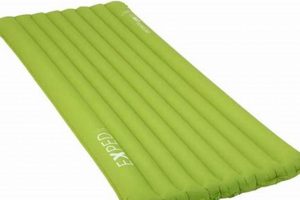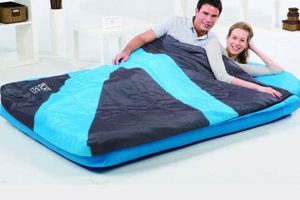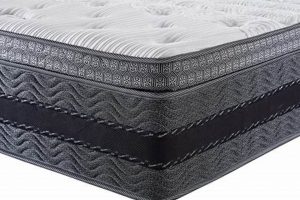A sleep surface designed to accommodate individuals who primarily rest on their abdomen. These products typically prioritize specific support characteristics to maintain spinal alignment and reduce pressure points. For example, a product with firmer support in the midsection can prevent excessive sinking of the hips, a common concern for this sleep position.
Proper support is crucial for individuals favoring the prone position to mitigate potential musculoskeletal issues. Without adequate support, the spine can become misaligned, leading to discomfort and potential long-term problems. The advent of specialized sleep surfaces represents a recognition of the diverse ergonomic needs of sleepers and aims to optimize comfort and health outcomes.
The following sections will delve into the critical factors to consider when selecting a suitable sleep surface, exploring the material composition, firmness levels, and other features essential for ensuring a restful and supportive sleep experience.
Selecting a Suitable Sleep Surface
The choice of a sleep surface significantly impacts comfort and spinal alignment for individuals who sleep on their abdomen. Prioritizing specific features can optimize the sleep experience and minimize potential discomfort.
Tip 1: Prioritize Firmness. A firmer sleep surface is generally recommended. This helps to prevent excessive sinking of the hips and abdomen, which can lead to spinal misalignment.
Tip 2: Consider Material Composition. Options include innerspring, memory foam, latex, and hybrid models. Evaluate the support characteristics of each material to determine the most suitable choice. Latex and firmer memory foam varieties can offer adequate support.
Tip 3: Evaluate Edge Support. Strong edge support is crucial, particularly for individuals who tend to move close to the edge of the bed during sleep. This prevents rolling off and maintains consistent support across the entire surface.
Tip 4: Assess Pressure Relief. While firm support is essential, some degree of pressure relief is also beneficial. A thin comfort layer on top of a supportive core can help alleviate pressure points on the ribs and stomach.
Tip 5: Examine Spinal Alignment. The primary goal is to maintain a neutral spinal alignment. The sleep surface should minimize curvature and prevent excessive pressure on the neck and lower back.
Tip 6: Check for Breathability. Overheating can disrupt sleep. Materials with enhanced breathability, such as latex or innerspring constructions, can help regulate temperature.
Tip 7: Review Trial Periods and Warranties. Reputable manufacturers offer trial periods, allowing individuals to test the sleep surface before committing to a purchase. A comprehensive warranty provides protection against manufacturing defects.
Choosing a supportive sleep surface can substantially enhance comfort and minimize the risk of musculoskeletal issues. Evaluating these factors will assist individuals in selecting a model that promotes proper spinal alignment and a restful sleep.
The subsequent discussion will address common misconceptions and offer further guidance on maintaining optimal spinal health while in the prone position.
1. Firmness Level
The firmness level of a sleep surface is a critical determinant of spinal alignment and comfort for individuals who favor sleeping on their stomach. The selection of an appropriate firmness is not merely a matter of preference, but rather a fundamental consideration for mitigating potential musculoskeletal strain.
- Spinal Alignment Maintenance
A firmer surface minimizes excessive sinking of the midsection, preventing spinal hyperextension. Insufficient firmness can result in an exaggerated arch in the lower back, potentially leading to discomfort and long-term spinal issues. The goal is to maintain a neutral spinal posture throughout the sleep cycle.
- Pressure Distribution
While firmness is paramount, appropriate pressure distribution is also necessary. Excessively firm surfaces can concentrate pressure on areas such as the ribs and stomach. A balance between firmness and cushioning is essential to minimize localized pressure points and enhance comfort.
- Core Engagement and Muscle Relaxation
A suitable firmness level facilitates proper core engagement during sleep. When the spine is adequately supported, the core muscles can relax, reducing the risk of muscle strain and stiffness upon waking. An inappropriately soft sleep surface can necessitate constant muscle engagement to maintain stability, leading to discomfort.
- Long-Term Musculoskeletal Health
Consistent use of a sleep surface with an inappropriate firmness level can contribute to chronic musculoskeletal problems. Spinal misalignment, caused by inadequate support, can exacerbate pre-existing conditions and increase the likelihood of developing new issues. Prioritizing firmness is a proactive measure for safeguarding long-term spinal health.
The interplay between firmness level and spinal health is undeniable. Selecting a sleep surface that effectively supports the spine while minimizing pressure points is essential for individuals who sleep on their stomach. A thoughtful evaluation of firmness, coupled with an understanding of individual ergonomic needs, is paramount for achieving restful and restorative sleep.
2. Support Core
The support core within a sleep surface provides the primary structural foundation, significantly impacting spinal alignment and overall comfort for individuals who sleep on their stomachs. It is not merely a component of the product, but rather a critical determinant of its suitability for this specific sleep position.
- Material Composition and Density
The material composition and density of the support core influence its capacity to resist compression and maintain a consistent surface. High-density foams or tightly coiled innerspring systems offer enhanced support, preventing excessive sinking of the midsection. In contrast, less dense materials may compress over time, compromising spinal alignment.
- Zoning and Targeted Support
Zoned support cores incorporate varying levels of firmness across different regions of the sleep surface. This feature allows for targeted support to specific areas, such as the hips and shoulders, promoting optimal spinal alignment. Zoning can be particularly beneficial for individuals who require additional support in the lumbar region.
- Innerspring Coil Count and Gauge
For innerspring models, the coil count and gauge are indicative of the support core’s resilience and durability. Higher coil counts and lower gauge values generally correspond to a firmer, more supportive sleep surface. The arrangement of the coils also impacts support distribution and motion isolation.
- Hybrid Construction and Layer Integration
Hybrid models combine different materials within the support core to achieve a balance of support and comfort. These models may feature a combination of innerspring coils, memory foam, and latex layers. The integration and layering of these materials influence the overall support characteristics and pressure relief.
The selection of a sleep surface with an appropriate support core is crucial for individuals who prioritize sleeping on their stomachs. An understanding of the materials, construction techniques, and zoning features is essential for selecting a product that promotes optimal spinal alignment and long-term comfort. The support core is the foundation for a healthy sleep posture and contributes significantly to overall well-being.
3. Surface Material
The surface material of a sleep surface significantly affects the comfort and support experienced by individuals who sleep on their stomachs. The composition of the uppermost layers dictates factors such as pressure distribution, temperature regulation, and ease of movement, all of which are paramount for this sleep position. For example, a surface composed of high-density memory foam may conform closely to the body, potentially leading to overheating and restricted movement, whereas a latex or breathable coil system might offer superior temperature regulation and easier repositioning.
Variations in surface material also impact spinal alignment. While a firm support core is necessary to prevent excessive sinking, the surface layer influences how weight is distributed across the body. A surface that is too soft can still allow the abdomen to sink, even with a supportive core, leading to spinal misalignment. Conversely, an excessively firm surface can create pressure points on the ribs and pelvis. Therefore, the ideal surface material strikes a balance between cushioning and support. The practical implication is that individuals should consider the density, responsiveness, and breathability of the surface material to ensure optimal comfort and spinal health.
In summary, the surface material is an integral component in creating a sleep surface appropriate for stomach sleepers. Its properties directly affect pressure distribution, temperature regulation, and ease of movement, all of which contribute to comfort and spinal alignment. Understanding the nuanced relationship between surface material and sleep quality is crucial for selecting a sleep surface that promotes restful and restorative sleep for those who favor the prone position.
4. Spinal Alignment
Spinal alignment is a critical consideration in the selection of a sleep surface, particularly for individuals who sleep on their stomachs. This sleep position inherently places stress on the spine due to the concentration of weight in the midsection. A properly designed sleep surface mitigates this stress by providing adequate support, thus maintaining the natural curvature of the spine and minimizing the risk of musculoskeletal issues. The absence of appropriate support results in spinal misalignment, potentially leading to lower back pain, neck stiffness, and other forms of discomfort. A sleep surface designed for stomach sleepers, therefore, prioritizes structural integrity and firmness to counteract the tendency of the spine to sag into an unnatural position.
The efficacy of a sleep surface in promoting spinal alignment directly impacts long-term musculoskeletal health. For example, an individual using an inadequately supportive sleep surface may experience chronic lower back pain, necessitating medical intervention. Conversely, a well-designed surface distributes weight evenly, reducing pressure on the spine and supporting proper posture during sleep. This preventative measure can alleviate existing discomfort and minimize the likelihood of developing new spinal issues. Furthermore, proper spinal alignment facilitates optimal respiratory function and reduces the likelihood of sleep disturbances.
In summary, the connection between spinal alignment and the selection of a suitable sleep surface for stomach sleepers is paramount. Prioritizing firmness, support, and contouring can significantly improve sleep quality and mitigate the risk of musculoskeletal problems. Understanding the ergonomic needs of stomach sleepers and the essential role of spinal alignment is crucial for selecting a sleep surface that promotes restful and restorative sleep.
5. Edge Support
Edge support is a significant consideration when selecting a sleep surface, especially for individuals who sleep on their stomachs. This feature refers to the structural reinforcement of the perimeter of the sleep surface, impacting both usable sleep area and overall stability.
- Usable Sleep Surface Area
Strong edge support maximizes the available sleep area. Individuals who sleep on their stomachs may utilize more of the sleep surface, including the edges, to find a comfortable position. Without adequate edge support, the perimeter may compress excessively, leading to a sensation of rolling off and restricting movement.
- Stability and Support Consistency
Enhanced edge support contributes to consistent support across the entire sleep surface. Individuals sleeping near the edge will receive the same level of support as those in the center, preventing spinal misalignment and ensuring a uniform sleep experience. This is particularly relevant for stomach sleepers who require consistent firmness to maintain proper posture.
- Ease of Entry and Exit
Robust edge support facilitates ease of entry and exit from the sleep surface. A stable edge provides a secure platform for sitting or standing, reducing the risk of falls and providing support for individuals with mobility limitations. This aspect is particularly important for those who may experience stiffness or discomfort when transitioning to or from a prone position.
- Durability and Longevity
Superior edge support enhances the overall durability and longevity of the sleep surface. Reinforced edges prevent sagging and deformation over time, maintaining the structural integrity of the sleep surface and extending its lifespan. This is a valuable consideration for individuals seeking a long-term investment in their sleep health.
The integration of robust edge support into sleep surface construction directly benefits individuals who sleep on their stomachs by maximizing usable space, ensuring consistent support, facilitating ease of movement, and extending the product’s lifespan. These factors collectively contribute to a more comfortable and supportive sleep environment.
6. Breathability
Breathability, in the context of sleep surfaces designed for individuals who sleep on their stomachs, refers to the ability of the materials to facilitate air circulation and dissipate heat. This characteristic directly impacts thermoregulation and, consequently, sleep quality. Stomach sleeping often leads to increased body contact with the sleep surface, which can restrict airflow and elevate body temperature. Insufficient breathability results in heat retention, promoting discomfort, restlessness, and fragmented sleep patterns. For example, a sleep surface constructed from dense, closed-cell memory foam may inhibit airflow, trapping heat and moisture, leading to a less comfortable sleep experience.
The composition and construction of a sleep surface significantly influence its breathability. Open-cell foam structures, innerspring systems with ample spacing between coils, and natural fibers such as latex or cotton promote air circulation. Conversely, synthetic materials with tightly packed structures tend to impede airflow. The practical significance of breathability is evident in the growing demand for sleep surfaces incorporating cooling technologies or materials specifically designed to enhance airflow. These innovations aim to mitigate the heat retention associated with stomach sleeping, thereby improving sleep comfort and reducing the likelihood of sleep disturbances. Furthermore, individuals residing in warmer climates or those prone to night sweats benefit disproportionately from sleep surfaces with superior breathability.
In summary, breathability is a crucial attribute of sleep surfaces intended for individuals who primarily sleep on their stomachs. Effective airflow and heat dissipation contribute directly to thermoregulation, promoting more restful and undisturbed sleep. The selection of appropriate materials and construction techniques is essential for maximizing breathability and mitigating the discomfort associated with heat retention. Understanding the importance of breathability enables consumers to make informed decisions and select sleep surfaces that best meet their individual needs and preferences.
7. Pressure Relief
Pressure relief, as it pertains to sleep surfaces designed for individuals who sleep on their stomachs, involves the capacity of the material to redistribute body weight and minimize concentrated pressure points. This characteristic is of particular importance in this sleep position due to the increased surface area contact and potential for localized discomfort on areas such as the ribs, stomach, and pelvis.
- Surface Conformity and Contouring
Surface conformity refers to the ability of the sleep surface to adapt to the unique contours of the body. Materials such as memory foam and latex possess inherent conforming properties, allowing them to redistribute weight and reduce pressure concentrations. For stomach sleepers, this is crucial for minimizing pressure on sensitive areas like the rib cage and abdomen. Without adequate surface conformity, localized pressure can lead to discomfort, restlessness, and disrupted sleep.
- Material Density and Resilience
The density and resilience of the sleep surface material significantly affect its pressure-relieving capabilities. Higher-density materials generally provide greater support and resistance to compression, while resilience refers to the material’s ability to return to its original shape after being compressed. A balanced combination of density and resilience ensures that the sleep surface can effectively redistribute weight without excessive sinking or the development of pressure points. For example, a high-density latex sleep surface offers both support and pressure relief, making it suitable for stomach sleepers.
- Zoned Support Systems
Zoned support systems incorporate varying levels of firmness across different regions of the sleep surface. This allows for targeted pressure relief to specific areas, such as the shoulders and hips, while maintaining adequate support in the midsection. Zoned support systems can be particularly beneficial for stomach sleepers who require different levels of support and pressure relief in various areas of the body to maintain proper spinal alignment and minimize discomfort.
- Surface Material Permeability and Airflow
The permeability of the surface material influences the dissipation of heat and moisture, which can indirectly affect pressure relief. Materials with enhanced permeability and airflow promote thermoregulation, preventing overheating and reducing the likelihood of pressure-related discomfort. For example, a sleep surface incorporating breathable cotton or wool can help regulate temperature and minimize the sensation of pressure buildup, contributing to a more comfortable sleep experience.
The integration of these pressure-relieving elements is essential for creating a sleep surface that accommodates the unique ergonomic needs of stomach sleepers. By minimizing pressure points and promoting spinal alignment, these features contribute to improved sleep quality, reduced discomfort, and enhanced overall well-being.
Frequently Asked Questions
The following addresses common inquiries and misconceptions surrounding the selection and utilization of sleep surfaces designed to accommodate individuals who predominantly sleep on their stomachs.
Question 1: Is a firm sleep surface always the best option for individuals who sleep on their stomachs?
While firmness is generally recommended to prevent excessive spinal curvature, an excessively firm surface can create pressure points. The ideal solution involves a balance between support and pressure relief, often achieved through a firm core with a conforming top layer.
Question 2: How does material composition impact the suitability of a sleep surface for stomach sleepers?
The material dictates support, breathability, and pressure relief. High-density foams and latex offer support, while open-cell structures and natural fibers enhance breathability. The selection should align with individual needs and preferences.
Question 3: Is edge support a critical feature for individuals who sleep on their stomachs?
Yes. Strong edge support maximizes the usable sleep surface area, prevents rolling off, and ensures consistent support across the entire surface, which is particularly beneficial for stomach sleepers who may shift positions during sleep.
Question 4: How can spinal alignment be assessed when selecting a sleep surface?
The spine should maintain its natural curvature when lying on the sleep surface. Avoid excessive sinking or arching of the lower back. Consulting a healthcare professional can provide personalized guidance.
Question 5: Does breathability significantly impact sleep quality for individuals who sleep on their stomachs?
Breathability is crucial for thermoregulation. Stomach sleeping can increase body contact with the sleep surface, potentially leading to overheating. Materials promoting airflow enhance comfort and prevent sleep disruption.
Question 6: What role does pressure relief play in selecting a suitable sleep surface?
Pressure relief minimizes concentrated pressure points on the ribs, stomach, and pelvis. Surface conformity and zoned support systems contribute to even weight distribution, reducing discomfort and promoting restful sleep.
Prioritizing these factors ensures the selection of a sleep surface that promotes proper spinal alignment, thermoregulation, and pressure distribution, optimizing sleep quality for prone sleepers.
The subsequent section will explore supplementary strategies for enhancing sleep hygiene and optimizing the sleep environment.
Optimizing Sleep Health with a Proper Mattress for Stomach Sleeper
The preceding exploration has underscored the multifaceted considerations inherent in selecting a `mattress for stomach sleeper`. Key points include the necessity for appropriate firmness, material composition, edge support, breathability, and pressure relief to ensure spinal alignment and mitigate potential musculoskeletal issues. Failure to address these factors may compromise sleep quality and long-term well-being.
The selection of a suitable sleep surface represents a significant investment in personal health. Individuals are encouraged to apply the principles outlined herein to inform their decision-making process, thereby fostering a sleep environment conducive to restorative rest and sustained musculoskeletal health. Further research and consultation with healthcare professionals are recommended to personalize sleep solutions and address individual ergonomic needs.





![Best Semi Truck Sleeper Mattress [Guide + Reviews] Organic & Natural Mattress Buyer’s Guide: Non-Toxic Sleep Solutions Best Semi Truck Sleeper Mattress [Guide + Reviews] | Organic & Natural Mattress Buyer’s Guide: Non-Toxic Sleep Solutions](https://mattressworldpa.com/wp-content/uploads/2025/07/th-1748-300x200.jpg)

